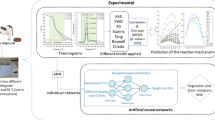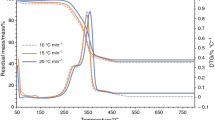Abstract
Marabú (Dichrostachys cinerea), a fast-growing shrub species, has garnered interest as a potential energy crop due to its properties. In developing thermochemical processes for utilising D. cinerea, specifically through pyrolysis, precise prediction of its behaviour is essential for optimising process efficiency and understanding the underlying mechanisms. This study focuses on comparing the effectiveness of kinetic and artificial neural network (ANN) modelling methods in predicting the pyrolysis of D. cinerea. Utilising thermogravimetric data at four different heating rates (5, 10, 20 and 40 °C/min), a kinetic model based on three independent parallel reactions was developed. In the ANN model, the input variables (heating rate (°C/min), temperature (°C) and time (min)) were used to predict the output variable: weight loss (%). To optimise a backpropagation neural network (BPNN), 4-fold cross-validation and Bayesian optimisation were employed. The findings demonstrate that both methods effectively predict weight loss, with the ANN model achieving superior accuracy in capturing experimental data, particularly at local maxima of weight loss, reflected by R2 values exceeding 0.99. The ANN method excels without the need for predetermined kinetic reaction mechanisms, showcasing its ability to adapt to complex, non-linear types of behaviour more accurately than traditional models. This study not only provides valuable insights into the pyrolytic behaviour of D. cinerea but also establishes a benchmark for future research in the predictive modelling of pyrolysis for diverse types of lignocellulosic biomass.




Similar content being viewed by others
Data availability
Data will be made available on request.
Code Availability
The code will be made available on request.
Abbreviations
- ANN:
-
Artificial neutral network
- BPNN:
-
Backpropagation neural network
- DTG:
-
Derivative thermogravimetry
- GPU:
-
Graphics processing unit
- GRG:
-
Generalised reduced gradient
- h:
-
Time step size in Runge-Kutta method
- k 1, k 2, k 3, and k 4 :
-
Intermediate slope calculations in Runge-Kutta method
- MSE:
-
Mean square error
- OF:
-
Objective function
- ReLU:
-
Rectified linear unit
- R² :
-
Coefficient of determination
- Tanh:
-
Hyperbolic tangent function
- TGA:
-
Thermogravimetric analysis
- α :
-
Learning rate
- β 1, β 2 :
-
Decay factors
- ϵ:
-
Small number to prevent division by zero
- m t , v t :
-
Estimates of the first and second moments
- ∇J(θ) :
-
Gradient of the objective with respect to parameters
References
Eksi G, Karaosmanoglu F (2017) Combined bioheat and biopower: a technology review and an assessment for Turkey. Renew Sustain Energy Rev 73:1313–1332. https://doi.org/10.1016/j.rser.2017.01.093
Reyes YA, Pérez M, Barrera EL, Martínez Y, Cheng KK (2022) Thermochemical conversion processes of Dichrostachys cinerea as a biofuel: a review of the Cuban case. Renew Sustain Energy Rev 160:112322. https://doi.org/10.1016/j.rser.2022.112322
Mortezaeikia V, Tavakoli O, Khodaparasti MS (2021) A review on kinetic study approach for pyrolysis of plastic wastes using thermogravimetric analysis. J Anal Appl Pyrol 160:105340. https://doi.org/10.1016/j.jaap.2021.105340
Hakeem IG, Halder P, Dike CC, Chiang K, Sharma A, Paz-Ferreiro J et al (2022) Advances in biosolids pyrolysis: roles of pre-treatments, catalysts, and co-feeding on products distribution and high-value chemical production. J Anal Appl Pyrol 166:105608. https://doi.org/10.1016/j.jaap.2022.105608
Ding Y, Zhang J, He Q, Huang B, Mao S (2019) The application and validity of various reaction kinetic models on woody biomass pyrolysis. Energy 179:784–791. https://doi.org/10.1016/j.energy.2019.05.021
Purnomo DMJ, Richter F, Bonner M, Vaidyanathan R, Rein G (2020) Role of optimisation method on kinetic inverse modelling of biomass pyrolysis at the microscale. Fuel 262:116251. https://doi.org/10.1016/j.fuel.2019.116251
Ding Y, Huang B, Li K, Du W, Lu K, Zhang Y (2020) Thermal interaction analysis of isolated hemicellulose and cellulose by kinetic parameters during biomass pyrolysis. Energy 195:117010. https://doi.org/10.1016/j.energy.2020.117010
González Rivera JE, Oliva Merencio D, Romero Vistín AS, Ledesma Acosta RD, Coronel Espinoza BD, Abreu-Naranjo R (2022) Thermogravimetric characteristics and kinetic modeling of Piptocoma discolor pyrolysis and combustion processes to contribute to its use as a renewable energy source in the Ecuadorian Amazon region. Biomass Convers Biorefinery :1–8
Conesa JA (2021) Numerical integration of weight loss curves for kinetic analysis. Thermo 1(1):32–44
Zhong Y, Ding Y, Jiang G, Lu K, Li C (2023) Comparison of artificial neural networks and kinetic inverse modeling to predict biomass pyrolysis behavior. J Anal Appl Pyrol 169:105802
Nawaz A, Kumar P (2022) Pyrolysis behavior of low value biomass (Sesbania bispinosa) to elucidate its bioenergy potential: kinetic, thermodynamic and prediction modelling using artificial neural network. Renewable Energy 200:257–270. https://doi.org/10.1016/j.renene.2022.09.110
Chen Z, Hu M, Zhu X, Guo D, Liu S, Hu Z et al (2015) Characteristics and kinetic study on pyrolysis of five lignocellulosic biomass via thermogravimetric analysis. Bioresour Technol 192:441–450
Çepelioğullar Ö, Mutlu İ, Yaman S, Haykiri-Acma H (2018) Activation energy prediction of biomass wastes based on different neural network topologies. Fuel 220:535–545. https://doi.org/10.1016/j.fuel.2018.02.045
Guo B, Li D, Cheng C, Lü Z-a, Shen Y (2001) Simulation of biomass gasification with a hybrid neural network model. Bioresour Technol 76(2):77–83. https://doi.org/10.1016/S0960-8524(00)00106-1
Sunphorka S, Chalermsinsuwan B, Piumsomboon P (2017) Application of artificial neural network for kinetic parameters prediction of biomass oxidation from biomass properties. J Energy Inst 90(1):51–61. https://doi.org/10.1016/j.joei.2015.10.007
ASTM-E1757-01 (2007) Standard practice for preparation of biomass for compositional analysis. ASTM International, West Conshohocken, PA
Abreu-Naranjo R, Foppa-Pedretti E, Romero-Romero O, Riva G (2010) Caracterización energética Del MARABÚ. Dyna 85(7):581–586
Abreu-Naranjo R, Conesa JA, Pedretti EF, Romero OR (2012) Kinetic analysis: simultaneous modelling of pyrolysis and combustion processes of dichrostachys cinerea. Biomass Bioenergy 36(0):170–175. https://doi.org/10.1016/j.biombioe.2011.10.032
J PG, V NK (2021) Google colaboratory: tool for deep learning and machine learning applications. Indian J Computer Sci 6(3–4). https://doi.org/10.17010/ijcs/2021/v6/i3-4/165408
Kimm H, Paik I, Kimm H (2021) Performance Comparision of TPU, GPU, CPU on Google Colaboratory over distributed deep learning. In: 2021 IEEE 14th International Symposium on Embedded Multicore/Many-core Systems-on-Chip (MCSoC)
Hecht-Nielsen R III (1989) 3 - Theory of the backpropagation neural network**based on nonindent by Robert Hecht-Nielsen, which appeared in Proceedings of the International Joint Conference on Neural Networks 1, 593–611, June © 1989 IEEE. In: Wechsler H, editor. Neural Networks for Perception: Academic Press; 1992. pp. 65–93
Ciuparu A, Nagy-Dăbâcan A, Mureşan RC (2020) Soft++, a multi-parametric non-saturating non-linearity that improves convergence in deep neural architectures. Neurocomputing 384:376–388. https://doi.org/10.1016/j.neucom.2019.12.014
Hu Z, Zhang J, Ge Y (2021) Handling vanishing gradient problem using artificial derivative. IEEE Access 9:22371–22377. https://doi.org/10.1109/ACCESS.2021.3054915
Glorot X, Bordes A, Bengio Y (2011) Deep sparse rectifier neural networks. InProceedings of the fourteenth international conference on artificial intelligence and statistics (pp. 315–323). JMLR Workshop and Conference Proceedings
Liu M, Yao D, Liu Z, Guo J, Chen J (2023) An improved Adam optimization algorithm combining adaptive coefficients and composite gradients based on randomized block coordinate descent. Comput Intell Neurosci 2023:4765891. https://doi.org/10.1155/2023/4765891
Mehmood F, Ahmad S, Whangbo TK (2023) An efficient optimization technique for training deep neural networks. Mathematics 11(6):1360
Arunsuriyasak P, Boonme P, Phasukkit P (2019) Investigation of deep learning optimizer for water pipe leaking detection. 2019 16th International Conference on Electrical Engineering/Electronics, Computer, Telecommunications and Information Technology (ECTI-CON)
Zhang C, Shao Y, Sun H, Xing L, Zhao Q, Zhang L (2024) The WuC-Adam algorithm based on joint improvement of warmup and cosine annealing algorithms. Math Biosci Eng 21(1):1270–1285. https://doi.org/10.3934/mbe.2024054
Jierula A, Wang S, OH T-M, Wang P (2021) Study on accuracy metrics for evaluating the predictions of damage locations in deep piles using artificial neural networks with acoustic emission data. Appl Sci 11(5):2314
Hastie T, Tibshirani R, Friedman JH, Friedman JH (2009) The elements of statistical learning: data mining, inference, and prediction. Springer
Alruqi M, Sharma P, Ağbulut Ü (2023) Investigations on biomass gasification derived producer gas and algal biodiesel to power a dual-fuel engines: application of neural networks optimized with bayesian approach and K-cross Fold. Energy 282:128336. https://doi.org/10.1016/j.energy.2023.128336
Theckel Joy T, Rana S, Gupta S, Venkatesh S (2019) A flexible transfer learning framework for bayesian optimization with convergence guarantee. Expert Syst Appl 115:656–72. https://doi.org/10.1016/j.eswa.2018.08.023
Xu L, Jiang Y, Wang L (2017) Thermal decomposition of rape straw: pyrolysis modeling and kinetic study via particle swarm optimization. Energy Conv Manag 146. https://doi.org/10.1016/j.enconman.2017.05.020
Di Blasi C (2008) Modeling chemical and physical processes of wood and biomass pyrolysis. Prog Energy Combust Sci 34:47–90. https://doi.org/10.1016/j.pecs.2006.12.001
Caballero JA, Conesa JA (2005) Mathematical considerations for nonisothermal kinetics in thermal decomposition. J Anal Appl Pyrol 73(1):85–100
Mood SH, Golfeshan AH, Tabatabaei M, Jouzani GS, Najafi GH, Gholami M et al (2013) Lignocellulosic biomass to bioethanol, a comprehensive review with a focus on pretreatment. Renew Sustain Energy Rev 27:77–93
Kanthasamy R, Almatrafi E, Ali I, Hussain Sait H, Zwawi M, Abnisa F et al (2023) Bayesian optimized multilayer perceptron neural network modelling of biochar and syngas production from pyrolysis of biomass-derived wastes. Fuel 350:128832. https://doi.org/10.1016/j.fuel.2023.128832
Adil M, Ullah R, Noor S, Gohar N (2022) Effect of number of neurons and layers in an artificial neural network for generalized concrete mix design. Neural Comput Appl 34(11):8355–8363. https://doi.org/10.1007/s00521-020-05305-8
Altriki A, Ali I, Razzak SA, Ahmad I, Farooq W (2022) Assessment of CO2 biofixation and bioenergy potential of microalga Gonium pectorale through its biomass pyrolysis, and elucidation of pyrolysis reaction via kinetics modeling and artificial neural network. Front Bioeng Biotechnol 10. https://doi.org/10.3389/fbioe.2022.925391
Sahoo A, Gautam R, Kumar S, Mohanty K (2021) Energy optimization from a binary mixture of non-edible oilseeds pyrolysis: Kinetic triplets analysis using Thermogravimetric Analyser and prediction modeling by Artificial Neural Network. J Environ Educ 297:113253. https://doi.org/10.1016/j.jenvman.2021.113253
Carvalho RFd, Pasolini VdH, Fraga Breciani JG, Silva Costa AB, Sousa RCd (2024) Poultry manure combustion parameters to produce bioenergy: a thermogravimetric analysis by isoconventional models and machine learning. Case Stud Therm Eng 53:103757. https://doi.org/10.1016/j.csite.2023.103757
Acknowledgements
The authors are indebted to Ms. Helen Pugh for her extensive proofreading of the manuscript.
Funding
This study was funded by Universidad Estatal Amazónica in Puyo.
Author information
Authors and Affiliations
Contributions
All authors contributed to the study conception and design. Material preparation, data collection and analysis were performed by R.A.-N., Y.Z., A.P.M. and Y.D. The first draft of the manuscript was written by R.A.-N., and all authors commented on previous versions of the manuscript. All authors read and approved the final manuscript.
Corresponding author
Ethics declarations
Ethics approval
Not applicable.
Conflict of interest
The authors declare no competing interests.
Additional information
Publisher’s Note
Springer Nature remains neutral with regard to jurisdictional claims in published maps and institutional affiliations.
Highlights
Kinetic modelling yielded R2 > 0.96 for D. cinerea pyrolysis.
ANN models achieved R2 > 0.99, outperforming kinetic models.
ANN captured local maxima of weight loss in a more competent way.
Rights and permissions
Springer Nature or its licensor (e.g. a society or other partner) holds exclusive rights to this article under a publishing agreement with the author(s) or other rightsholder(s); author self-archiving of the accepted manuscript version of this article is solely governed by the terms of such publishing agreement and applicable law.
About this article
Cite this article
Abreu-Naranjo, R., Zhong, Y., Pérez-Martínez, A. et al. Kinetic and Artificial neural network modelling of marabú (Dichrostachys cinerea) pyrolysis based on thermogravimetric data. Biomass Conv. Bioref. (2024). https://doi.org/10.1007/s13399-024-05759-z
Received:
Revised:
Accepted:
Published:
DOI: https://doi.org/10.1007/s13399-024-05759-z




